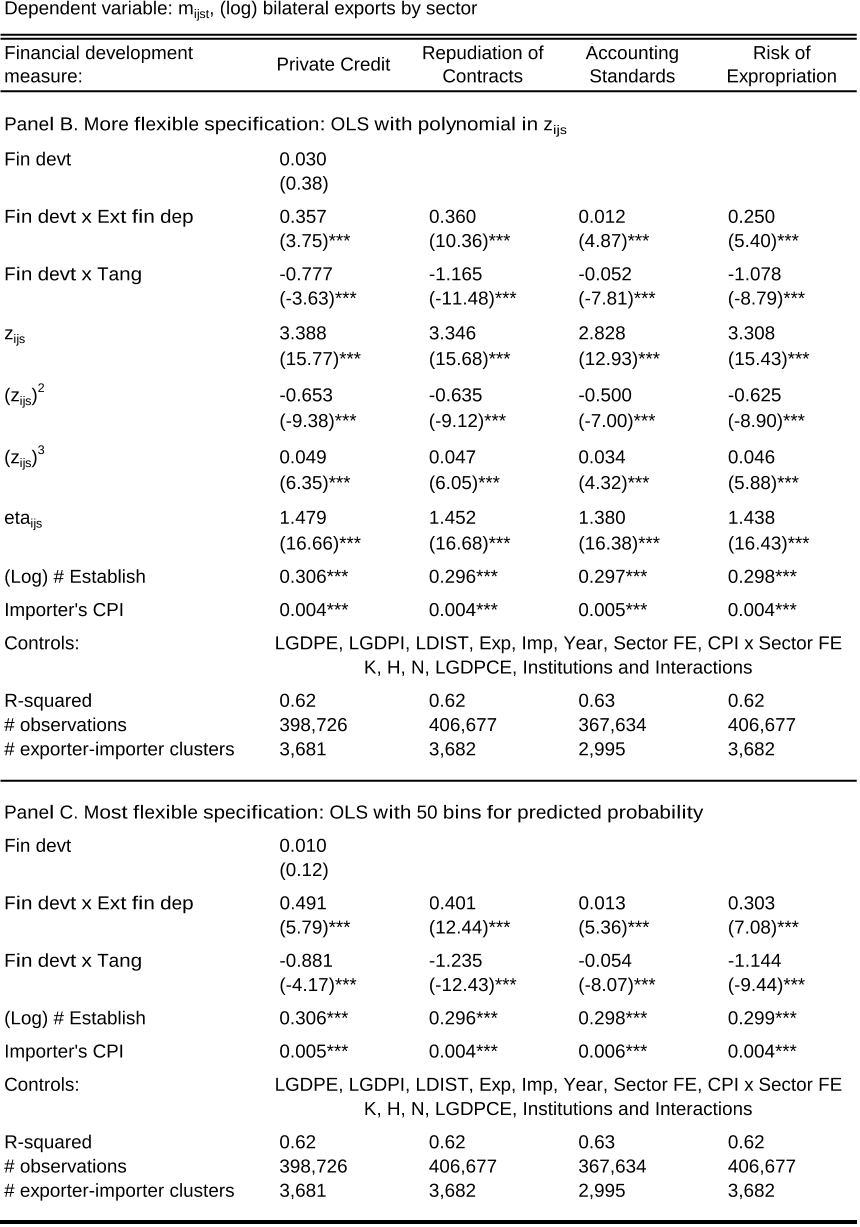Credit Constraints, Heterogeneous Firms and International Trade
Reads0
Chats0
TLDR
This article examined the detrimental consequences of financial market imperfections for international trade and developed a heterogeneous-firm model with countries at different levels of financial development and sectors of varying financial vulnerability.Abstract:
This paper examines the detrimental consequences of financial market imperfections for international trade. I develop a heterogeneous-firm model with countries at different levels of financial development and sectors of varying financial vulnerability. Applying this model to aggregate trade data, I study the mechanisms through which credit constraints operate. First, financial development increases countries' exports above and beyond its impact on overall production. Firm selection into exporting accounts for a third of the trade-specific effect, while two thirds are due to reductions in firm-level exports. Second, financially advanced economies export a wider range of products and their exports experience less product turnover. Finally, while all countries service large destinations, exporters with superior financial institutions have more trading partners and also enter smaller markets. All of these effects are magnified in financially vulnerable sectors. These results have important policy implications for less developed economies that rely on exports for economic growth but suffer from poor financial contractibility.read more
Figures

Table 10. Economic Significance: Predicted vs. Actual Trade Growth 
Table 9. Economic Significance: Comparative Statics 
Table 5. Financial Development and Firm-Level Exports 
Figure 3. The Productivity Cut-off for Exporting 
Table 5. Financial Development and Firm-Level Exports 
Table 1. Export Patterns in the Data
Citations
More filters
Journal ArticleDOI
How Does Trade Openness Affect Output Growth? A Perspective from the Input Diversity
Jiajie Yu,Shuang Meng +1 more
TL;DR: This article investigated whether trade openness facilitates output growth by improving access to intermediate inputs and found that industries more diversified in intermediate inputs will grow by 2.6 percentage points faster in more outward-oriented countries.
International integration as a vector for the brazilian economic recovery: proposals for stimulating exports
Ivan Tiago Machado Oliveira,Fernando José da Silva Paiva Ribeiro,Luís Fernando Tironi,Marcelo José Braga Nonnenberg,Flavio Lyrio Carneiro,Glauco Avelino Sampaio Oliveira +5 more
TL;DR: In this article, the authors provide an overview of the current situation and a brief diagnosis of some major policy issues associated with exports, including export credit and promotion, agricultural goods exports, technical standards, the multilateral framework of international trade regulation, and trade agreement negotiations.
Journal ArticleDOI
Leverage, corporate governance, and export intensity of heterogeneous firms: micro-level evidence for Pakistan
Kicking the bad apples out: Tariliberalization and bilateral trade
TL;DR: In this paper, the authors present a simple model in which liberalization of a common tariff need not increase bilateral imports from all export sources, and they find that tariff reductions increased trade from high income/high-price exporters, and had an insignificant or negative effect on trade from low-income/low price exporters.
Posted Content
Financial Constraints, Firm Characteristics and Exports: Evidence from Turkish Manufacturing Firms
Almıla Burgaç Çil,Fikret Dülger +1 more
TL;DR: In this article, the authors examined the relationship among firm exports and financial constraints and the other firm characteristics as total factor productivity (TFP), foreign demand growth, market concentration and mark-up using firm-level data of Turkish manufacturing sector for the period of 2003-2013 in terms of the heterogeneous firm trade models as the analysis unite for international trade models that have led to a comprehensive change in international trade theories since the 1990s.
References
More filters
Posted Content
Law and Finance
Rafael La Porta,Rafael La Porta,Florencio Lopez de Silanes,Florencio Lopez de Silanes,Andrei Shleifer,Andrei Shleifer,Robert W. Vishny,Robert W. Vishny +7 more
TL;DR: This paper examined legal rules covering protection of corporate shareholders and creditors, the origin of these rules, and the quality of their enforcement in 49 countries and found that common law countries generally have the best, and French civil law countries the worst, legal protections of investors.
Journal ArticleDOI
Law and Finance
TL;DR: In this article, the authors examined legal rules covering protection of corporate shareholders and creditors, the origin of these rules, and the quality of their enforcement in 49 countries and found that common-law countries generally have the strongest, and French civil law countries the weakest, legal protections of investors, with German- and Scandinavian-civil law countries located in the middle.
Journal ArticleDOI
The Impact of Trade on Intra-Industry Reallocations and Aggregate Industry Productivity
TL;DR: This paper developed a dynamic industry model with heterogeneous firms to analyze the intra-industry effects of international trade and showed how the exposure to trade will induce only the more productive firms to enter the export market (while some less productive firms continue to produce only for the domestic market).
Journal ArticleDOI
Finance and Growth: Schumpeter Might Be Right
TL;DR: In this paper, the authors examined a cross-section of about 80 countries for the period 1960-89 and found that various measures of financial development are strongly associated with both current and later rates of economic growth.
ReportDOI
Financial Dependence and Growth
Raghuram G. Rajan,Raghuram G. Rajan,Raghuram G. Rajan,Luigi Zingales,Luigi Zingales,Luigi Zingales +5 more
TL;DR: This paper examined whether financial development facilitates economic growth by scrutinizing one rationale for such a relationship; that financial development reduces the costs of external finance to firms, and found that industrial sectors that are relatively more in need of foreign finance develop disproportionately faster in countries with more developed financial markets.